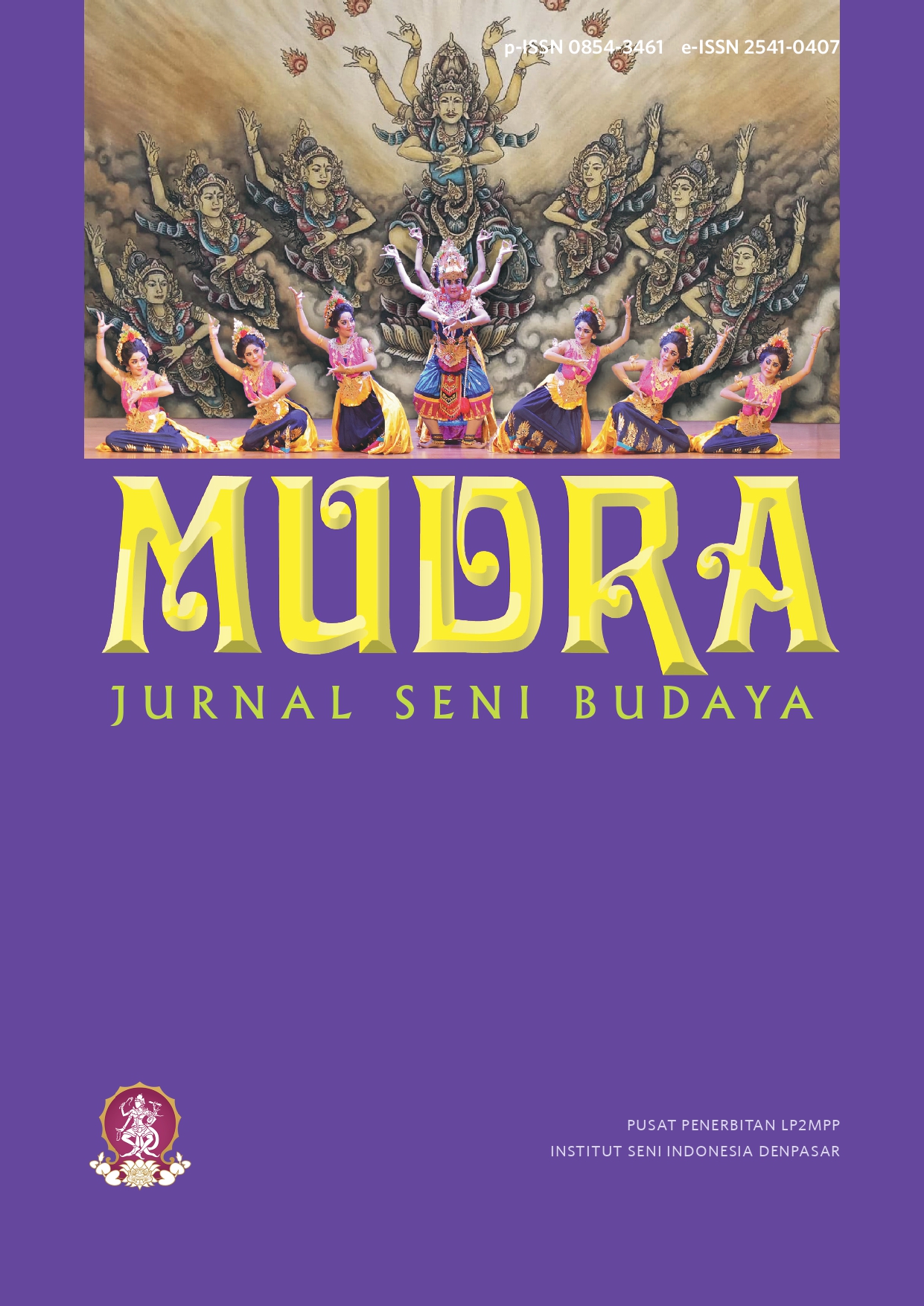Onomatopoeia: When Sound Is Seen
DOI:
https://doi.org/10.31091/mudra.v38i1.2220Keywords:
phonograms, onomatopoeia, comics, signs, meaning productionAbstract
Phonogram is a visual element in comics that represents the existence of sound. Together with picture elements, they both create a construction that is governed by a narrative. As a manifestation of sound, phonogram’s existence also delivers a message in the form of signs. By using a semiotic approach, this study seeks to identify the nature of the phonogram, its function, and the way it is produced and perceived. Symbolic messages are created to dramatize comics. Because of phonogram’s nature that imitates stereotypes in the real world, comic artists lead the reader to agree on the false reality presented in comic works. Phonogram’s creation requires two step interpretations, namely interpretation of sound and interpretation of visualization. The form of expression on the phonogram is not universal, because it refers to certain cultural stereotypes.
Downloads
References
Ardhianto, P. 2014. Makna Tipografi Onomatopoeia Pada Komik “Tigan Ngasak Batavia”. Gelar: Jurnal Seni Budaya, 12(1).
Ardianto, D. T., Susanto, D., & Mataram, S. 2018. Onomatopoea sebagai Pembuka Signifikasi Teks dalam Komik Tintin Petualangan Tintin Penerbangan 714 ke Sidney versi Terjemahan Bahasa Indonesia. Mudra Jurnal Seni Budaya, 33(2), 223-231.
Aryamova, T.V. 2014. Classes of Russians in their free time. Bulletin of the Taganrog Institute of Management and Economics, 1 (19).
Barthes, R. 2012. Elemen-Elemen Semiologi terjemahan Kahfie Nazaruddin. Yogyakarta: Jalasutra.
Bhaskoro, S. B. 2012. Aplikasi pengenalan gender menggunakan suara. In Seminar Nasional Aplikasi Teknologi Informasi (SNATI).
Budiman, K. 2012. Semiotika Visual: Konsep, Isu, dan Problem Ikonisitas. Yogyakarta: Jalasutra
Butonova, N.V. 2012. Leisure practices in modern culture. Bulletin of the Leningrad State University. AS Pushkin, 2 (1).
Castells, M. 2019.Information era. Economics, society and culture. Litres.
Corkia, E.D. 2008. Performance as a sociocultural phenomenon of the postmodern era. Moscow: MAKS Press, 21(1).
Denzin, N. K., & Yvonna S. Lincoln. 2009. Handbook of Qualitative Research. Yogyakarta: Pustaka Pelajar
Dewi, N. E., & Musdolifah, A. 2018. Onomatope dalam Webtoon Komik Kisah Usil Si Juki Kecil Karya Faza Meonk Universitas Balikpapan. Jurnal Basataka (JBT), 1(2), 47-51.
Eisner, W. 1985. Comic and Sequential Art. Florida: Poorhouse Press
Golovin, G.V., & Vedernikov, V.P. 2016. The leisure culture of the individual and the process of its formation in the modern information society. Scientific Bulletin of the Southern Institute of Management, (1).
Golovina, G.V. 2010. Leisure culture as a factor in the formation of modern society. Bulletin of the Adygea State University. Series 1: Regional Studies: Philosophy, History, Sociology, Jurisprudence, Political Science, Cultural Studies, (4).
Goodman, N. 1968. Language of Art. New York: The Bobbs-Merrill Company.Inc.
Grushetskaya, I.N. 2012. Features of the organization of youth leisure.Bulletin of Kostroma State University. Series: Pedagogy. Psychology. Sociokinetics, 18 (1-2).
Harisah, A., dan Masiming, Z. 2008. Persepsi manusia terhadap tanda, simbol dan spasial. SMARTek, 6(1).
Ibatova, A.Z. 2019. The content and structure of future engineers' communicative culture. Humanities and Social Sciences Reviews, 7(4), 762-766.
Kamaeva, R.B. 2014. National cultural specifics of representing dialecticisms in the fiction work translation. Life Science Journal, 11(10), 95, 653-656.
Kleiberg, Y.A. 2015. Downshifting as the mainstream of deviant behavior. Penza Psychological Bulletin, (2).
McCloud, S. 2001. Memahami Komik terjemahan S. Kinanti. Jakarta: Kepustakaan Populer Gramedia.
Miftakhov, A.F., et al. 2019. Effectiveness of using football basics in physical education and organizing arts and cultural events for promoting harmonious development of orphan children. International Journal of Instruction, 12(1), 539-554.
Prasetya, B. W., Susanto, B., & Purwadi, J. 2011. Identifikasi Suara Pria dan Wanita Berdasarkan Frekuensi Suara. Jurnal Informatika, 4(1).
Pronina, L.A. 2008. Information, information society and man. Analytics of Cultural Studies, (11).
Sadykova, O.G. 2015. Culture as a resource of socialization and youth education. Science, Education and Culture, 2(2).
Safiullin, M.R. 2019. Production of indicators for evaluation of digital transformation of modern university. International Journal of Engineering and Advanced Technology, 9(1), 7399-7402.
Saraceni, M. 2003. The Langue of Comics. New York: Routledge
Scoraya, I.G. 2019. The culture of free time in a network society. Bulletin of the Grodno State University named after Yanka Kupala. T. 9. No. 2.
Sumartono. 2017. Metodologi penelitian Kualitatif Seni Rupa dan Desain. Jakarta: Pusat Studi Reka Rancang Visual dan Lingkungan Universitas Trisakti.
Tabrani, P. 2005. Bahasa Rupa. Kabupaten Bandung: Penerbit Kelir.
Tooth, Y.A. 2007. The Risk Phenomenon in Sociology: A Study of Youth. Musl.
Varlamova, S.N., Goncharova, E.R., &Sokolova, I.V. 2015. Internet addiction of youth in megacities: criteria and typology. Public Opinion Monitoring: Economic and Social Change, 2 (125).
Winoto, Y., & Yusup, P. M. 2017. Penerapan Teori Integrasi Informasi dalam Penelitian Bidang Perpustakaan: Sebuah Kajian Teoritis. Pustaha: Jurnal Studi Perpustakaan dan Informasi, 13(2).
Downloads
Published
How to Cite
Issue
Section
License
Copyright (c) 2022 Deny Tri Ardianto, Sayid Mataram, Anugrah Irfan Ismail, Arif Ranu Wicaksono

This work is licensed under a Creative Commons Attribution-NonCommercial-ShareAlike 4.0 International License.
- Copyright on any open access article in a journal published by Mudra Jurnal Seni Budaya is retained by the author(s).
-
The Creative Commons Attribution License 4.0 formalizes these and other terms and conditions of publishing articles.









